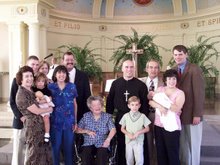Today is the 4th anniversary of Hurricane Katrina making lives interesting in Louisiana, and as it so happens, I’ve been reading for a class on how religions institutionalize memory. What particularly interests me is how we make wounds into sacred wounds to memorialize trauma. There is actually a show on MTV called Scarred (or something like that), which is mostly about extreme athletes telling stories of hurting themselves really badly and showing off the resulting scars while videos of their accidents replay over and over. (Seriously, I only watched it for about 3 minutes…really.) I remember seeing the news from Halloween in New Orleans in 2005, and a lot of people made costumes that poked fun at our collective plight – wearing the spray-painted markings that the National Guard put on houses they searched, for example. Some people have deliberately kept those markings on their houses, or kept the waterlines on their outer walls, as a way of remembering what happened here. People who go through initiation rites often receive some kind of permanent marking (scar, tattoo, wound, lost tooth, branding, whatever) as a way of marking them as initiated men or women and reminding them of their own mortality. Mythic traditions often do the same, from the dislocated hip of Jacob in Genesis or the boy prince’s golden finger in the Eisenhans story to Harry Potter’s lightning scar or Luke Skywalker’s lost hand. What I think all of these sacred wounds are pointing to in some way is compassion. Richard Rohr, OFM says that he can only think of two things that have much chance of teaching us wisdom: suffering and contemplative prayer (I suspect they have to go together). This is because, on one hand, they remind us that we can’t take our own projects with final seriousness and that we are much more mortal than we would like to believe, and on the other hand, because we’re not the only ones with sacred wounds. Seeing our own wounds had better open us up to acknowledging the wounds of others, or we will simply turn inwards on our own bitterness or self-absorption and play victims.
As a side note, Hosea 11:8 has God say, “How could I treat you as Admah, or make you like Zeboiim?” Admah and Zeboiim are code words for Sodom and Gomorrah – how can I do this kind of violence to my child? Then, the text says, “My heart is overwhelmed,” and the word used here is the same word used in the Sodom and Gomorrah story for “earthquake” – God is taking the earthquake of anger at injustice and unfaithfulness into God’s own heart and being torn apart by it. Kazoh Kitamori, a Japanese theologian, envisioned God, in the words of German theologian Dorothee Soelle, “as one who suffers because of sin and yet cannot maintain his wrath, who reconciles wrath and love in pain because he loves the object of his wrath, which always entails suffering.” Not our usual God-image, perhaps, but what is the Sacred Heart, my community’s central symbol, but the institutionalization of the suffering of God in and on behalf of the world? So, to wrap up on this day of memorializing the scars that are hanging on in Mississippi and Louisiana four years later, are those memories opening us up to acknowledge the unbelievable plethora of sacred wounds in the world that remain unhealed? I regularly use Merton’s quote from The Sign of Jonas to talk about God, but maybe we can point it at ourselves too…mercy within mercy within mercy.
Saturday, August 29, 2009
Subscribe to:
Post Comments (Atom)






4 comments:
This post is extraordinary. Thank you.
This is Fran from St. Edward's. I also have a personal blog and I have linked to you from there.
This post says so much, it really collided with many of my own thoughts of late.
Blessings and prayers.
Your blog keeps getting better and better! Your older articles are not as good as newer ones you have a lot more creativity and originality now keep it up!
brpatricksblog.blogspot.com; You saved my day again.
Post a Comment